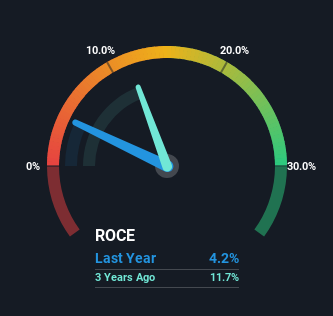Returns On Capital At Rongsheng Petrochemical (SZSE:002493) Have Hit The Brakes

If we want to find a potential multi-bagger, often there are underlying trends that can provide clues. Firstly, we'd want to identify a growing return on capital employed (ROCE) and then alongside that, an ever-increasing base of capital employed. Ultimately, this demonstrates that it's a business that is reinvesting profits at increasing rates of return. However, after investigating Rongsheng Petrochemical (SZSE:002493), we don't think it's current trends fit the mold of a multi-bagger.
Understanding Return On Capital Employed (ROCE)
For those that aren't sure what ROCE is, it measures the amount of pre-tax profits a company can generate from the capital employed in its business. The formula for this calculation on Rongsheng Petrochemical is:
Return on Capital Employed = Earnings Before Interest and Tax (EBIT) ÷ (Total Assets - Current Liabilities)
0.042 = CN¥9.4b ÷ (CN¥375b - CN¥153b) (Based on the trailing twelve months to December 2023).
So, Rongsheng Petrochemical has an ROCE of 4.2%. In absolute terms, that's a low return and it also under-performs the Chemicals industry average of 5.8%.
See our latest analysis for Rongsheng Petrochemical

In the above chart we have measured Rongsheng Petrochemical's prior ROCE against its prior performance, but the future is arguably more important. If you'd like, you can check out the forecasts from the analysts covering Rongsheng Petrochemical for free.
The Trend Of ROCE
There are better returns on capital out there than what we're seeing at Rongsheng Petrochemical. The company has consistently earned 4.2% for the last five years, and the capital employed within the business has risen 234% in that time. This poor ROCE doesn't inspire confidence right now, and with the increase in capital employed, it's evident that the business isn't deploying the funds into high return investments.
On a side note, Rongsheng Petrochemical's current liabilities are still rather high at 41% of total assets. This can bring about some risks because the company is basically operating with a rather large reliance on its suppliers or other sorts of short-term creditors. While it's not necessarily a bad thing, it can be beneficial if this ratio is lower.
The Bottom Line
As we've seen above, Rongsheng Petrochemical's returns on capital haven't increased but it is reinvesting in the business. Unsurprisingly, the stock has only gained 33% over the last five years, which potentially indicates that investors are accounting for this going forward. So if you're looking for a multi-bagger, the underlying trends indicate you may have better chances elsewhere.
On a final note, we found 3 warning signs for Rongsheng Petrochemical (2 are significant) you should be aware of.
While Rongsheng Petrochemical may not currently earn the highest returns, we've compiled a list of companies that currently earn more than 25% return on equity. Check out this free list here.
New: AI Stock Screener & Alerts
Our new AI Stock Screener scans the market every day to uncover opportunities.
• Dividend Powerhouses (3%+ Yield)
• Undervalued Small Caps with Insider Buying
• High growth Tech and AI Companies
Or build your own from over 50 metrics.
Have feedback on this article? Concerned about the content? Get in touch with us directly. Alternatively, email editorial-team (at) simplywallst.com.
This article by Simply Wall St is general in nature. We provide commentary based on historical data and analyst forecasts only using an unbiased methodology and our articles are not intended to be financial advice. It does not constitute a recommendation to buy or sell any stock, and does not take account of your objectives, or your financial situation. We aim to bring you long-term focused analysis driven by fundamental data. Note that our analysis may not factor in the latest price-sensitive company announcements or qualitative material. Simply Wall St has no position in any stocks mentioned.
About SZSE:002493
Rongsheng Petrochemical
Engages in the research, development, production, and sale of chemical, oil, and polyester products.
Average dividend payer with moderate growth potential.
Market Insights
Community Narratives



